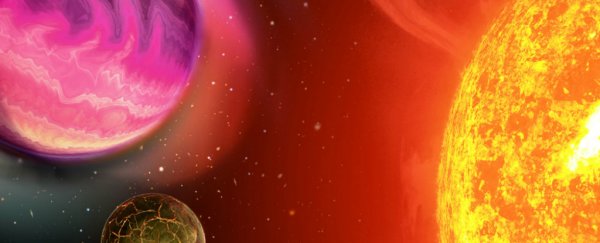Astronomers have discovered a new type of star system that defies everything we know about the formation of the Solar System.
Known as a 'binary-binary', the system has two stars orbiting each other incredibly closely (like a traditional binary system), but the primary star also has two massive structures of its own in orbit. This is the first binary-binary system ever discovered - and its existence suggests that we might be very wrong about how solar systems are born.
This isn't the first time scientists have cast doubt on our current understanding of solar system formation - the very existence of Pluto and its strange orbit has been a thorn in the proverbial side of our best hypotheses. But the new evidence suggests that it might be time to consider other options about the early stages of solar systems.
Right now, most scientists think that our Solar System, and others out there, formed from a collapsed disk-like gaseous cloud around our Sun - with our largest planet, Jupiter, only staying so big because it was buffered from smaller planets by the asteroid belt.
That makes sense, but it doesn't really account for Pluto, and it's weird, inclined orbit. If Pluto formed in the flat, collapsed disk of gas like all the other planets and asteroids in our system, why isn't it still orbiting on the same plane?
Researchers have managed to explain this inconsistency by suggesting that all the planets in our Solar System have migrated as they grew.
But the new binary-binary system delivers another blow against this collapsed disk model.
That's because the two giant objects orbiting the primary star have accumulated way more dust and gas than is possible in that scenario, leading the researchers to suggest that they were formed through another, currently unknown mechanism.
"For such large companion objects to be stable so close together defies our current popular theories on how solar systems form," explains a release from the University of Florida, which lead the research.
The binary-binary, which is more officially known as HD 87646, was first spotted in 2006 by the planet-hunting W. M Keck Exoplanet Tracker, and is estimated to be around 240 light-years away.
But it was a "very bizarre" finding, says one of the researchers, Bo Ma, and it took eight years of follow-up data collection using telescopes around the world before researchers could confirm what they'd seen.
The system is made up of two stars that are only 22 astronomical units apart, which is roughly the distance between the Sun and Uranus. (An astronomical unit is the distance from the centre of Earth and our Sun.)
The primary star is 12 percent more massive than our Sun, and the secondary star is about 10 percent less massive.
While in terms of stars, that's pretty damn close to each other, it's not unheard of - we've seen binary systems before, and sometimes one of the stars even has something orbiting it.
But what's weird about this system is that the primary star has two massive structures orbiting it - a giant planet that's around 12 times more massive than Jupiter, and a brown dwarf, or 'failed star', that's 57 times more massive than Jupiter.
That's incredibly big, but both those objects are only between 0.1 and 1.5 astronomical units away from their star - which means they're around the same distance as Earth is from the Sun.
The team is now completing more observations of the system to try to figure out exactly how so many massive structures all in one place manage to exist stably - and then they have the fun task of putting forward new hypotheses about how this bizarre system, and perhaps our own Solar System, might have formed.
It's still too early to say for sure whether our understanding of our Solar System's formation will need any tweaking or not - it could be the case that something else entirely is going on in this new binary-binary.
But it's nice to know that science can respond and update itself in the face of new evidence. The more we find out about the Universe around us, the more we have to learn.
The research has been published in the Astronomical Journal, and you can read it in full on arXiv.org.
